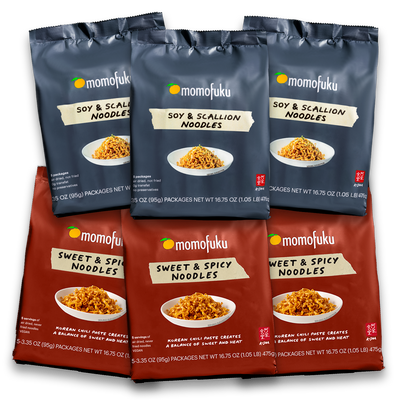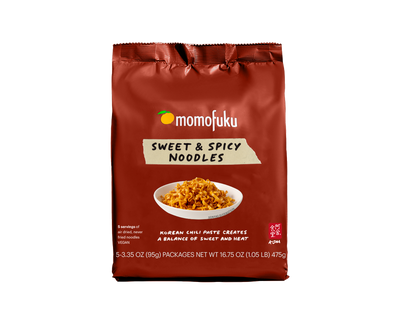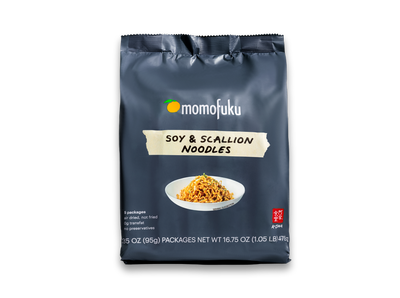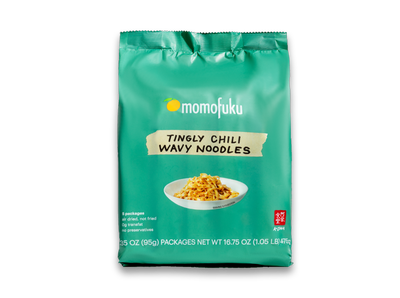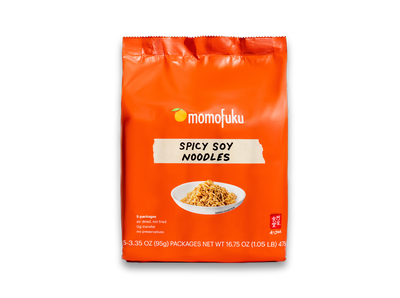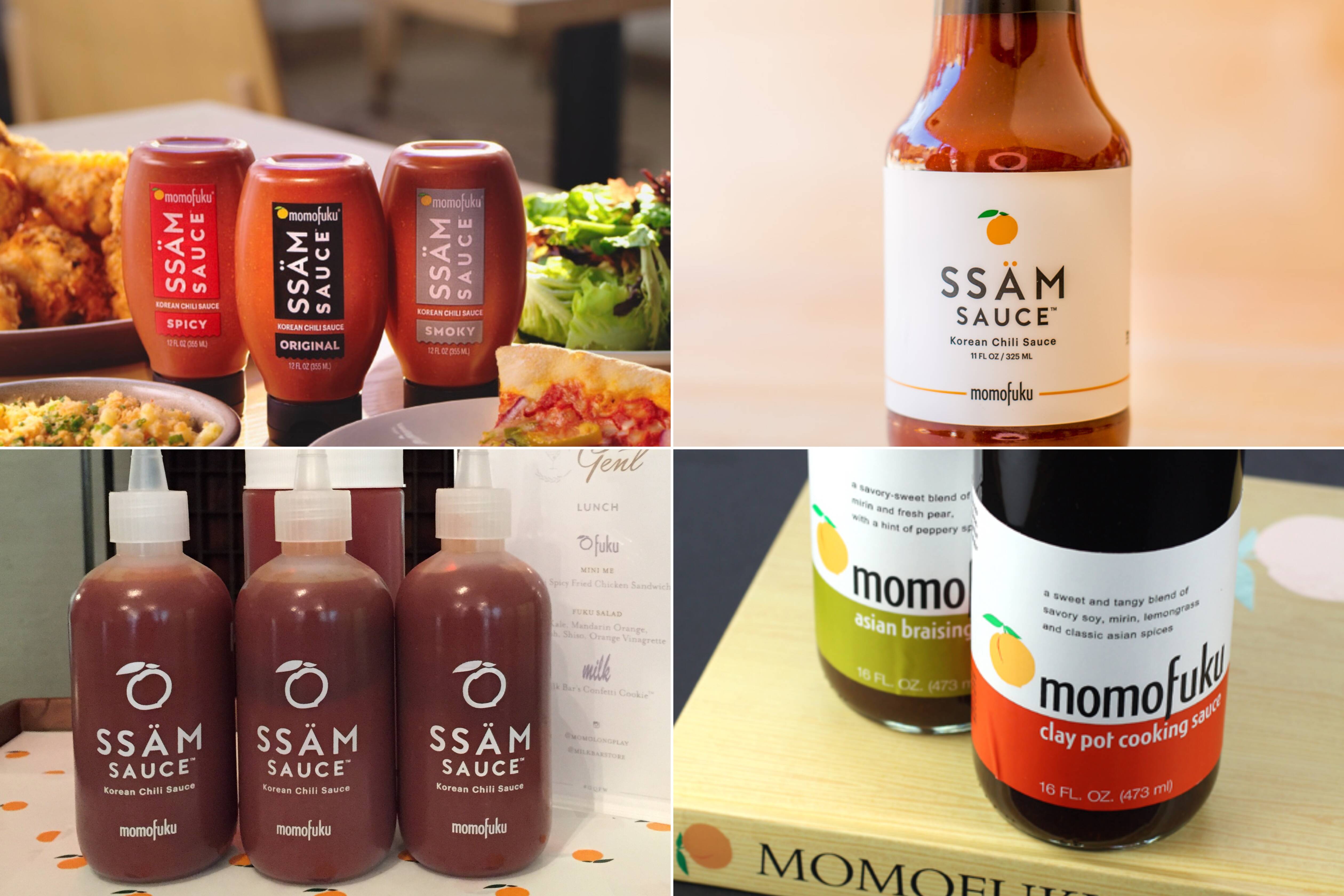
The History of Momofuku Korean BBQ Sauces
The History of Momofuku Korean BBQ Sauces Content
At Momofuku Goods, product development begins with the restaurants. Over the past 20 years of cooking for thousands of people, what dishes and flavors do people keep coming back for? What ingredients have remained consistently part of our menus since 2004? What are the crucial pantry staples that we’re not seeing in most grocery stores and home kitchens?
That particular combination of sweet, salty, sour, and a little bit spicy is as close to a universal standard as you’re likely to find. Think about the world of BBQ sauces. Whether you’re talking about American BBQ sauces like Sweet Baby Ray’s, Japanese tare like Bachan’s, or Cantonese char siu marinades, all these sauces, though distinct in origin and ingredients, share a common appeal: they’re rich, savory, and perfect with meat.
These connections are what thrill us about food. Momofuku’s kitchens have always strived to find these points of commonality, and that continues to be true with our new Korean BBQ Sauces. They draw from the rich flavors of dishes Dave's mother prepared during his childhood. Her spicy chicken stew (dakdoritang) and spicy chicken stir-fry (dakgalbi) inspired our Sweet & Spicy Korean BBQ Sauce, while the marinades she used for bulgogi and galbi influenced our Sweet & Savory Korean BBQ Sauce. But if you close your eyes, you might be reminded of flavors from your own, completely different upbringing.
A host of sauces built on these flavors have been part of Momofuku since the initial menu at Noodle Bar in 2004. For instance, sweet and spicy gochujang-based sauces have shown up in various forms through the years. A thin, glossy yangnyeom glaze coated the Korean Fried Chicken, while a thicker, more concentrated sauce showed up on our tteokbokki (spicy roasted rice cakes). With the addition of vinegar and oil, the same basic sauce made up the ssamjang we serve with our whole-roasted pork shoulder at Ssäm Bar. Similarly, for years, different versions of our Sweet & Savory Korean BBQ Sauce have been our go-to marinade for grilled meats.
Developing these sauces for home use has been a journey of perfecting ratios and consistency. Our initial foray into home cooking products began with Ssäm Sauce, a staple at Momofuku Noodle Bar that eventually made its way onto grocery shelves. Following its discontinuation in 2019, we’ve spent five years refining these sauces to enhance their versatility and ease of use, drawing from our community’s desire for quick ways of using restaurant-level flavors at home. We adjusted ratios to balance the acidity, dialed in the perfect amount of heat, and, most importantly, adjusted the consistency to broaden its applications.
Ssäm Bar, our original sauce’s namesake, closed in 2023 while we were deep in development of these sauces. The new names better reflect its broad uses. Similarly, Sweet & Savory Korean BBQ Sauce was adapted for home cooks. It’s thicker than traditional galbi marinades, more in line with classic American BBQ sauces. We love that versatility—our sauces are easy to brush on, dip into, or marinate with, yet still simple to thin out or doctor it up, however you like.
Since we first launched Ssäm Sauce, we’re happy to see a rapidly growing interest in bottled sauces with Asian flavor bases. Our home kitchens are stocked with many of these products, and each have their specific uses. With our new line of sauces, we were set on bringing the history of Momofuku to consumers with something that stands apart, both in its versatility and its flavor.
Both of our new sauces incorporate fruit—apple in the Sweet & Spicy and pear in Sweet & Savory—which isn’t commonly found in grocery store offerings. We love apples and pears because of the malic acid that gives them their tartness. This natural compound tenderizes meat without compromising texture, enhances flavor by balancing sweetness with a hint of tartness, and stimulates salivation, opening up the palate to more flavors.
Like everything we do at Momofuku, our sauces are based in traditional culinary practices as well as our specific experience. Are these sauces perfect for everything? No. But they are true to our culinary philosophy and Dave’s Korean-American upbringing. They’re also our best effort to broaden the offerings of the BBQ-sauce shelf, and hopefully move toward a more diverse and delicious culinary future for everyone.
Timeline
2004: Momofuku Noodle Bar opens. Opening menu features bibim nengmyun, a cold Korean noodle dish tossed in a sweet & spicy gochujang-based sauce.
2006: Momofuku Ssäm Bar opens serving ssäm wraps and rice bowls, topped with our earliest versions of Ssäm Sauce, which would become a precursor to our Sweet & Spicy Korean BBQ Sauce.
2007: Momofuku Ssäm Bar overhauls its menu. New, expanded menu features a hanger steak marinated in a sweet-soy marinade like our Sweet & Savory Korean BBQ Sauce.
2009: Our large-format fried chicken meal hits the menu at Momofuku Noodle Bar. One half is southern-style fried chicken; the other half is based on Yangnyeom-chikin, or gochujang-glazed Korean Fried Chicken.
2010: Momofuku Culinary Lab opens in Brooklyn. The lab is dedicated to researching fermented foods. The team produces Hozon, a miso-like product made from things like chickpeas and sunflower seeds, Bonji, a soy sauce-like product made with New York grains, and Ssäm Sauce for use in our restaurants.
2015: Our first time selling Ssäm Sauce to the public. We produced this version in our lab and sold it at Whole Foods in New York.
2018: Ssäm Sauce goes nationwide. We worked with KraftHeinz to make a version of Ssäm Sauce in mass retail. (We stopped selling this product in 2019.)
2019: Momofuku Goods is born with the introduction of Seasoned Salts. Customers immediately begin to ask us to bring back Ssäm Sauce.
2021: Momofuku Ssäm Bar moves to the South Street Seaport and becomes a Korean BBQ restaurant. Meats are marinated in a sweet-soy sauce reminiscent of Ssäm Bar’s early days and served with ssamjang. These flavors directly inspire our new products and we start work on making them commercially available.
2022: Internal tasting of “gochujang” and “galbi” sauces. By December samples are ready to send to members of our Momofuku Crew Facebook group for testing and initial feedback.
2023: Ssäm Bar closes, solidifying our need to come up with new names for these products. We begin bottle prototyping and getting feedback from more members of our community.
2024: 20 years after we started using these sauces in our restaurants, 5 years after we last made Ssäm Sauce, and after endless variations of R&D, our Korean BBQ Sauces are ready.
More Reading and Resources
Comprehensive List of Korean Seasonings (양념 Yangnyeom)
Korean Pantry List of Essentials
Analysis of Korean Dipping Sauces & Korean Seasoning Sauces
Korean Essential Seasoning Ingredients
Hansik: The Taste of Korea
Global Center for K-Food
NPR Podcast on Korean Food
Gochujang-Based Marinades:
Gochujang (고추장): Gochujang is a fermented chili paste made from red chili powder, glutinous rice powder, fermented soybeans, and salt. It has been a staple in Korean cuisine for centuries, dating back to the 18th century or even earlier. The spicy, savory, and slightly sweet flavor profile of gochujang adds depth and complexity to marinades and sauces.
Historical Context: Gochujang was traditionally made in Korean homes during the autumn months when fresh peppers were harvested. It was fermented in large earthenware pots called onggi, which were buried underground for aging. The fermentation process could last several months to develop the desired flavor profile.
Culinary Significance: Gochujang-based marinades are versatile and used in various Korean dishes, including grilled meats (such as bulgogi and galbi), stews (like jjigae), and even in dipping sauces. Its popularity has spread globally, with many chefs incorporating it into fusion dishes and recipes.
Soy Sauce (간장): Soy sauce is a fundamental ingredient in Korean cuisine, as well as in many other East Asian cuisines. It is made from fermented soybeans, roasted grains (such as wheat), salt, and water. The exact origins of soy sauce are unclear, but it has been used in Korean cooking for centuries, likely introduced via trade with China.
Historical Context: Soy sauce has been produced in Korea since at least the Goryeo Dynasty (918–1392). Initially, it was primarily used as a condiment and seasoning. Over time, it became a key ingredient in marinades, imparting a savory, umami-rich flavor to meats and other dishes.
Culinary Significance: Soy-based marinades are prevalent in Korean BBQ, where meats are marinated in a mixture of soy sauce, garlic, sesame oil, and other ingredients before grilling. This marinade not only enhances the flavor of the meat but also helps tenderize it.

